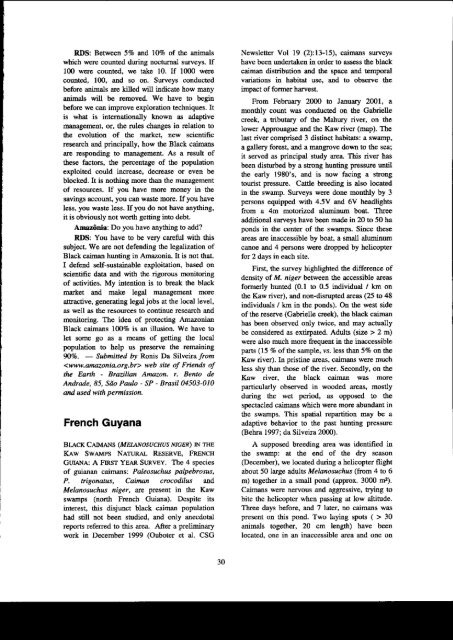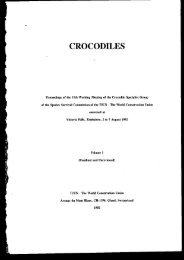NEWSLETTER - Crocodile Specialist Group
NEWSLETTER - Crocodile Specialist Group
NEWSLETTER - Crocodile Specialist Group
Create successful ePaper yourself
Turn your PDF publications into a flip-book with our unique Google optimized e-Paper software.
RDS: Between 5Vo ard 10% of the anirnals<br />
which were counted during nocturnal surveys. If<br />
100 were counted, w€ take 10. If 1000 were<br />
counted, 10O, aud so on. Surveys conducted<br />
before animals are killed will hdicate how many<br />
animals will be removed. We have to b€gin<br />
before we can improve exploration techniques. It<br />
is what is intemationally known as adaptive<br />
managernent, or, t]le rules changes in relation to<br />
the evolution of the market, new scientific<br />
research and principally, how the Black cairnans<br />
are responding to rnanagement. As a result of<br />
ttres€ factors, the percetrtage of the population<br />
exploited could increase, decrease or even be<br />
blocked. It is nothing more than the mauagement<br />
of resources. If you have more money in fhe<br />
savings account, you can waste more. If you have<br />
loss, you waste less. If you do not have anythhg,<br />
it is obviously not worth geEing into debt-<br />
Amaz6nia: Do you have anything to add?<br />
RDS: You have to be very carei.rl with this<br />
subject. We are not defending tle legalization of<br />
Black caiman hunting in Amazonia. It is not that.<br />
I defend self-sustainable exploitation, based on<br />
scietrtific data and with the rigorous monitoring<br />
of activities. My intention is to break the black<br />
market and make legal management more<br />
attractive, generating legal jobs at the local level,<br />
as well as the resources to continue research and<br />
monitoring. The idea of protecting Amazonian<br />
Black caimans lfi)% is an illusion. We have to<br />
let some go as a mea.ns of getting the loca.l<br />
population to help us preserve the remaidng<br />
9QVo. - Subnitted Dy Ronis Da Silveira /zom<br />
web site of Fiends of<br />
the Eanh - Braziliu Arnazon. r. Bento de<br />
Andrade, 85, Sdo Paulo - SP - Brasil M503-010<br />
and used wtth oermission-<br />
French Guyana<br />
BI.ACK CAIMANS (MEIANOSUCHUS NIGER) IN.TIIE<br />
KAw SWAMPS NATURAL RTSERVE, F!3NCH<br />
CtnANA: A FRsr YEAR SLRvEy. The 4 species<br />
of guianan cairnats. Pcleosuchus palpebrosus,<br />
P. trigonatus, Caimat crocodtlus and<br />
Melanosuchus nlgel, arc pr€sent in tle Kaw<br />
swamps (north French Guiana). Despite its<br />
inbrest, this disju]lct black caiman population<br />
had still not be€n studied, and only anecdotal<br />
reports referred to tlis area. After a preliminary<br />
work in December 1999 (Ouboter et al, CSG<br />
Newsletter vol 19 (2):13-15), caimans surveys<br />
have been undertaken in order to assess the black<br />
caiman distribution and the space and temporal<br />
variations in habitat use, aDd to observe tle<br />
impact of former harvest.<br />
From February 2fi)O to January 2001, a<br />
monthly count was conducted on the Gabrielle<br />
creek, a tributary of the Mahury river, on the<br />
lower Approuague and the Kaw river (map). The<br />
last river comprised 3 distinct habitats: a snamp,<br />
a gallery forest, and a nangrove down to the sea;<br />
it served as principal study area- This river has<br />
been disturbed by a strong hunting pressure until<br />
the early 1980's, and is now facing a strong<br />
tourist pressure. Catde breeding is also located<br />
in the swamp. Surveys were done monthly by 3<br />
persons equipped with 4.5v and 6V headlighs<br />
from a 4m motorized aluminum boaL Three<br />
additional surveys have been made in 20 to 50 ha<br />
ponds in the certer of the swamps. Since these<br />
areas are inaccessible by boat, a small alumhum<br />
canoe and 4 persons were dropped by helicopter<br />
for 2 days in each site.<br />
First, the survey highlighted fte difference of<br />
density of M. niger between the accessible areas<br />
formerly hrmted (0.1 to 0.5 individual / krn on<br />
the Kaw river), and ron-disrupted areas (25 to 48<br />
individuals / km in the ponds). On the west side<br />
of the reserve (Gabrielle creek), tlte black caiman<br />
has been observed only twice, and rnay actually<br />
be considered as extirpated. Adults (size > 2 m)<br />
were also much more ftequent in tle inaccessible<br />
parts (15 % ofthe sample, vs. less than 5% onthe<br />
Kaw river), In pristine areas, cairnans were much<br />
less shy than those of the river. Secondly, on the<br />
Kaw river, the black caiman was more<br />
particularly observed in wooded areas, mosdy<br />
during the wet period, as opposed to the<br />
spectacled caimans which were more abundant in<br />
the swamps. This spatial repartition may be a<br />
adaptive behavior to the past hunting pressure<br />
(Behra 1997; da Silveira 2000).<br />
A supposed breeding area was identified in<br />
thc swamp: at the end of the dry season<br />
@ecember), we located during a helicopter flight<br />
about 50 large adtlts Melanosuchu,r (ftDm 4 to 6<br />
m) together in a small pond (approx. 3000 m2).<br />
Cairnans were nervous and aggressive, trying to<br />
bite dle helicopter when passing at low altihrde.<br />
Three days before, and ? later, no caimals was<br />
present on this pond. Two lalng spots ( > 30<br />
animals together, 20 cm length) have been<br />
located, one in an inaccessible area and one on<br />
30

















